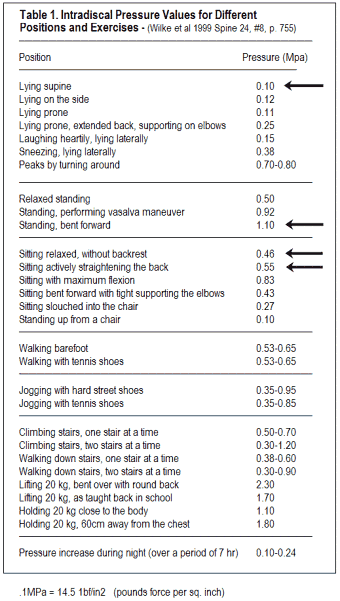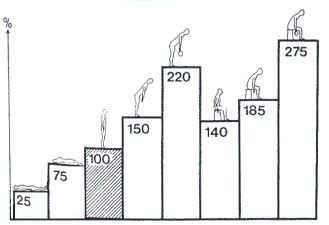| Disc Pressure Measurements
Prove That the Pressure on the Disc
is 11 Times Greater When the Patient is Erect:
Therefore, the FONAR Upright™ MRI Is the ONLY Appropriate
Technology For
Evaluating Low Back Pain and For Choosing the
Best Surgical Repair
by Raymond Damadian, MD., President, Fonar Corporation
Melville,
N.Y., June 12, 2006
Direct
measurements of disc pressure (1,2) establish
quantitatively that the forces on the recumbent intervertebral
disc are only
a fraction
of what they are on the upright disc. Indeed, on the basis of
these direct in vivo measurements of  disc pressure it would appear
that an examination of the patient lying down is not a relevant
examination for the patient experiencing back pain when he is
upright(3). Indeed the data strongly suggests that the recumbent-only
MRI carries the very real prospect of either grossly underestimating
the patient's spinal pathology because the forces causing it
have been removed, or not seeing the pathology at all for the
same reason. disc pressure it would appear
that an examination of the patient lying down is not a relevant
examination for the patient experiencing back pain when he is
upright(3). Indeed the data strongly suggests that the recumbent-only
MRI carries the very real prospect of either grossly underestimating
the patient's spinal pathology because the forces causing it
have been removed, or not seeing the pathology at all for the
same reason.
The
data prove unequivocally that for the approximately 9,000,000 patients
scanned annually in the MRI for upright back pain (3),
the FONAR Upright™ MRI examination is the relevant examination.
In 1999, H. J. Wilke
et al.(1)at the Institute for Orthopedic Research and Biomechanics,
University of Ulm, Germany reported direct in vivo measurements of pressures
in the intervertebral disc in 28 body positions (Table 1) utilizing a pressure
transducer implanted directly in the nucleus pulposus of a healthy non-degenerated
L4-L5 disc of a male volunteer.
The direct measurements
of disc pressure by Wilke et al.(1)show unequivocally that the recumbent
disc is subject to a pressure that is only a tiny fraction of the pressure exerted
on that same disc when the patient is standing and bending forward. Indeed, the
pressure exerted on the disc when the patient is standing erect and bending forward
is 11 times what the pressure is on the disc when the patient is recumbent.
Additionally, the
data corroborates the original intradiscal pressure measurements made by Nachemson
et al.(2)on the L3-L4 disc of volunteers (Fig. 2 from Nachemson et
al.).
Except for the fact
that Nachemson found that the maximal disc pressure occurred in the partially
flexed erect sitting position, while Wilke et al. found it occurred standing
and partially
flexed (a variation which could be attributable to the fact that Wilke et al.
measured the L4-L5 disc while Nachemson measured the L3-L4 disc), the general
result was the same. The upright disc pressure was more than 10 times greater
than the recumbent disc pressure. Indeed, the pressure exerted on the upright
L3-L4 disc in the seated partially flexed position is also 11 times the pressure
the recumbent L3-L4 disc experiences when recumbent, and is the same pressure
multiple that Wilke et al. measured.

Fig
2. Relative change in pressure (or load) in the
third lumbar disc in various
positions in living subjects |
These
direct intradiscal measurements of disc pressure make it clear
that the MR imaging evaluation of
the patient upright is the relevant examination, and that the MRI examination
of the patient recumbent is not.
According to the
Center for Disease Control and Prevention, U.S. Department of Health and Human
Services there are 916,000 surgeries of the spine performed each year in the
U.S.(4). The number is comparable in magnitude to the 950,000 cardio-vascular
operations performed annually in the U.S., the total of stent placements, coronary
bypass surgeries, angioplasties, heart transplants, valve replacements and
congenital heart repairs.
Additionally,
there are approximately 9,000,000 MRI examinations of the spine performed annually
in the U.S
Given
that the burden of the spine is to carry weight and that the
purpose of these 9,000,000
annual spine MRI examinations is to determine the origin of back pain in
these patients, examining the spine with the weight removed in
a recumbent-only MRI
does not address the patient's need. Indeed, the inadequacy of the weightless
MRI for assessing spinal pathology is self-evident.
Direct measurements of intervertebral disc pressure in various body positions
prove this fact quantitatively.
Moreover, the recumbent-only
MRI examination possesses the risk to the patient of providing the wrong
diagnosis and thereby causing the wrong surgery. This outcome carries with
it the unfortunate
prospect of adding the patient to the ranks of those who make up the high
number of "multiply operated surgical cripples"(5)that
comprise the Failed
Back Surgery Syndrome (FBSS) (2,6,7,8,9,10,11).
It is thus clear,
that for the 916,000 patients who undergo spine surgery each year and for
the approximately 9,000,000 patients who receive MRI scans of the spine annually
for back pain, that these patients should all be receiving vertical MRI examinations
to achieve proper diagnosis of their problems. INDEED THE DATA FROM THE DIRECT
IN VIVO MEASUREMENTS OF DISC PRESSURE MAKE IT SELF-EVIDENT THAT IT IS IMPOSSIBLE
TO ACHIEVE A CORRECT DIAGNOSIS OF A PATIENT'S BACK PAIN WHEN THE COMPRESSIVE
FORCES CAUSING THAT BACK PAIN HAVE BEEN REMOVED.
(1) H-J. Wilke, P. Neef, M. Caimi,
T. Hoogland and L. E. Claes, Spine 24, #8, pp. 755-762, 1999.
(2) A. L. Nachemson, Spine 1, #1, pp. 59-71, 1976
(3) the great majority of back pain patients
(4) National Hospital Discharge Survey: 2003. Vital
and Health Statistics Series 13, Number 160, U.S. Department
of Health and
Human Services Center for Disease Control and Prevention, National
Center for Health Statistics, Hyattsville, Maryland
(5) A. L. Nachemson, Spine 1, #1, p. 65, 1976
(6) The acronym set aside to identify patients whose
symptoms have their origin in prior unsuccessful surgery.
(7) M. Szpalski, R.Gunzburg, Eds., The Failed Spine,
Lippincott Williams & Wilkins, 2005
(8) M. L. Rowe, J. Occup Med 7:196-202, 1965
(9) S. S. Leavitt, T. L. Johnston, R. D. Beyer, Ind
Med Surg 40:7-14, Nov. 1971
(10) S. S. Leavitt, T. L. Johnston, R. D. Beyer, Ind
Med Surg 40(9):7-15, Dec. 1971
(11) A. Hakelius, Acta Orthop Scand (Suppl
129), 1972
About FONAR
FONAR® was incorporated in 1978, making it the first, oldest
and most experienced MRI manufacturer in the
industry. FONAR introduced the world's first commercial MRI in
1980, and went public in 1981. Since its inception, FONAR has
installed hundreds of MRI scanners worldwide. Their stellar product
line includes the FONAR UPRIGHT™ MRI (also known as the
Stand-Up™ MRI), the only whole-body MRI that performs
Position™
imaging (pMRI) and scans patients in numerous weight-bearing
positions, i.e. standing, sitting, in flexion and extension,
as well as the
conventional lie-down position. The FONAR UPRIGHT™ MRI
often sees the patient's problem that other scanners cannot
because
they are lie-down only. With nearly one half million patients
scanned, the patient-friendly FONAR UPRIGHT™ MRI has a
near zero claustrophobic rejection rate by patients. A radiologist
said, "FONAR UPRIGHT™ MRI - No More Claustrophobia
- The Tunnel Is Gone." As another FONAR customer states,
"If the patient is claustrophobic in this scanner, they'll
be claustrophobic in my parking lot." Approximately 85%
of patients are scanned sitting while they watch a 42" flat
screen TV. FONAR's latest MRI scanner is the FONAR 360, a room-size
recumbent scanner that optimizes openness while facilitating
physician access to the patient. FONAR is headquartered on
Long Island,
New York, and has approximately 400 employees.
#
The Inventor of MR Scanning™, True
Flow™ MRI, Stand-Up™ MRI, FONAR UPRIGHT™ MRI,
Position™ MRI, PMRI™ and The Proof is in the Picture™
are trademarks of FONAR® Corporation.
This release may include
forward-looking statements from the company that may or may not
materialize. Additional information on factors that could potentially
affect the company's financial results may be found in the company's
filings with the Securities and Exchange Commission.
###
FONAR™ Corporation
110 Marcus Drive
Melville, N.Y. 11747
Tel. 631-694-2929
Fax. 631-390-9540
Email sales@FONAR.com
Investor Information
Printable
Version (PDF)

Site Map
| Terms of Use-Our
Privacy Policy Use
Copyright © 2006 FONAR- All Rights Reserved |

 disc pressure it would appear
that an examination of the patient lying down is not a relevant
examination for the patient experiencing back pain when he is
upright(3). Indeed the data strongly suggests that the recumbent-only
MRI carries the very real prospect of either grossly underestimating
the patient's spinal pathology because the forces causing it
have been removed, or not seeing the pathology at all for the
same reason.
disc pressure it would appear
that an examination of the patient lying down is not a relevant
examination for the patient experiencing back pain when he is
upright(3). Indeed the data strongly suggests that the recumbent-only
MRI carries the very real prospect of either grossly underestimating
the patient's spinal pathology because the forces causing it
have been removed, or not seeing the pathology at all for the
same reason. 